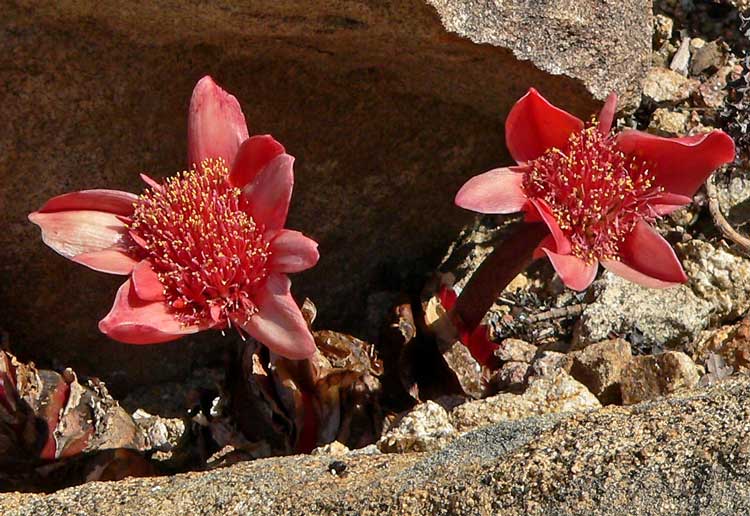
Haemanthus coccineus (Information about this image)
Classification System: APG IV
Superregnum: Eukaryota
Regnum: Plantae
Cladus: Angiosperms
Cladus: Monocots
Ordo: Asparagales
Familia: Amaryllidaceae
Subfamilia: Amaryllidoideae
Tribus: Haemantheae
Genus: Haemanthus
Species: Haemanthus coccineus
Name
Haemanthus coccineus L., 1753
Synonyms
Haemanthus callosus Burch. ex Baker
Haemanthus carinatus L.
Haemanthus coarctatus Jacq.
Haemanthus coccineus var. carinatus Herb.
Haemanthus coccineus var. coarctatus (Jacq.) Herb.
Haemanthus coccineus var. grandivalvis Herb., not validly publ.
Haemanthus concolor Herb.
Haemanthus crassipes Jacq.
Haemanthus hookerianus Herb.
Haemanthus hyalocarpus Jacq.
Haemanthus latifolius Salisb.
Haemanthus moschatus Jacq.
Haemanthus splendens Dinter
Haemanthus tigrinus Jacq.
Haemanthus zebrinus Herb.
Perihemia coarctata (Jacq.) Raf.
Distribution
Native distribution areas:
Haemanthus coccineus
Continental: Africa
Regional: Southern Africa
Cape Provinces; Namibia
References: Brummitt, R.K. 2001. TDWG – World Geographical Scheme for Recording Plant Distributions, 2nd Edition
References
Linnaeus, C. 1753. Species Plantarum. Tomus I: 325. Reference page.
Links
Govaerts, R. et al. 2018. Haemanthus coccineus in World Checklist of Selected Plant Families. The Board of Trustees of the Royal Botanic Gardens, Kew. Published on the internet. Accessed: 2018 Jul. 31. Reference page.
International Plant Names Index. 2018. Haemanthus coccineus. Published online. Accessed: Jul. 31 2018.
Tropicos.org 2018. Haemanthus coccineus. Missouri Botanical Garden. Published on the internet. Accessed: 2018 Jul. 31.
USDA, ARS, Germplasm Resources Information Network. Haemanthus coccineus in the Germplasm Resources Information Network (GRIN), U.S. Department of Agriculture Agricultural Research Service. Accessed: 08-Apr-12.
Vernacular names
Afrikaans: Bergajuin, Bloedblom
English: Blood flower, Paintbrush lily
Haemanthus coccineus, the blood flower, blood lily or paintbrush lily, is a species of flowering plant in the amaryllis family Amaryllidaceae, native to Southern Africa. Growing to 35 cm (14 in) tall and wide, it is a bulbous perennial with short brown stems surmounted by red flowers, the flowers appearing in spring and summer, before the strap-shaped leaves.[2]
The generic name Haemanthus is derived from the Greek words haima for blood and anthos for flower; coccineus is the Latin word for red or scarlet. In the Afrikaans language it is known as bergajuin, bloedblom, and many other vernacular names.[3]
Distribution
Haemanthus coccineus is widespread throughout the winter rainfall region in Southern Africa - from the southern parts of Namibia, to South Africa in the Cape Peninsula, to the Keiskamma River in the Eastern Cape.[3] It is found in Renosterveld and Fynbos habitats.
It is an adaptable species, growing in a wide range of soils derived from sandstones, quartzites, granites, shales and limestones. It will survive annual rainfall ranging from 100–1,100 millimetres (3.9–43.3 in). The plant adapts to a wide range of altitudes, being found from coastal dunes to 1,200 metres (3,900 ft) high mountains. It is hardy down to about 1 °C (34 °F) but does not survive freezing temperatures for any length of time.[2]
It is often found in clumps of hundreds, under the shelter of other shrubs on flat land, or in shady ravines and rock crevices.
Flower emerging.
Foliage.
Description
The flowerheads of Haemanthus coccineus emerge between February and April, with scarlet spathe valves on them like bright shaving brushes, make it a striking plant. The flowers are soon followed by translucent, fleshy berries. There are usually two large leaves per bulb, and occasionally three, which appear after flowering.[3]
The brilliant flowerheads account for its early appearance in Europe, being described by Carl Linnaeus in 1762. Together with Haemanthus sanguineus (Jacq.), this was the first Haemanthus to be introduced to European horticulture as an ornamental plant. In cultivation in the UK, H. coccineus has gained the Royal Horticultural Society’s Award of Garden Merit.[2][4] It can be grown outdoors in a warm, frost-free, sheltered, south-facing location.
Despite Linnaeus' description, this same species was described under a host of different names (see gallery captions), which reflects more on taxonomic disorganisation than species variability. The plant figured on the left, was first described as Haemanthus hyalocarpus by Jacquin in 1804, and those in the gallery below, which are all H. coccineus, were first described under the caption names.
See also
Cape Floristic Region
List of plants known as lily
References
"The Plant List: A Working List of All Plant Species". Retrieved 18 February 2015.
"RHS Plantfinder - Haemanthus coccineus". Retrieved 3 March 2018.
PlantZAfrica.com accessed 11.11.2011
"AGM Plants - Ornamental" (PDF). Royal Horticultural Society. July 2017. p. 45. Retrieved 2 March 2018.
Retrieved from "http://en.wikipedia.org/"
All text is available under the terms of the GNU Free Documentation License

